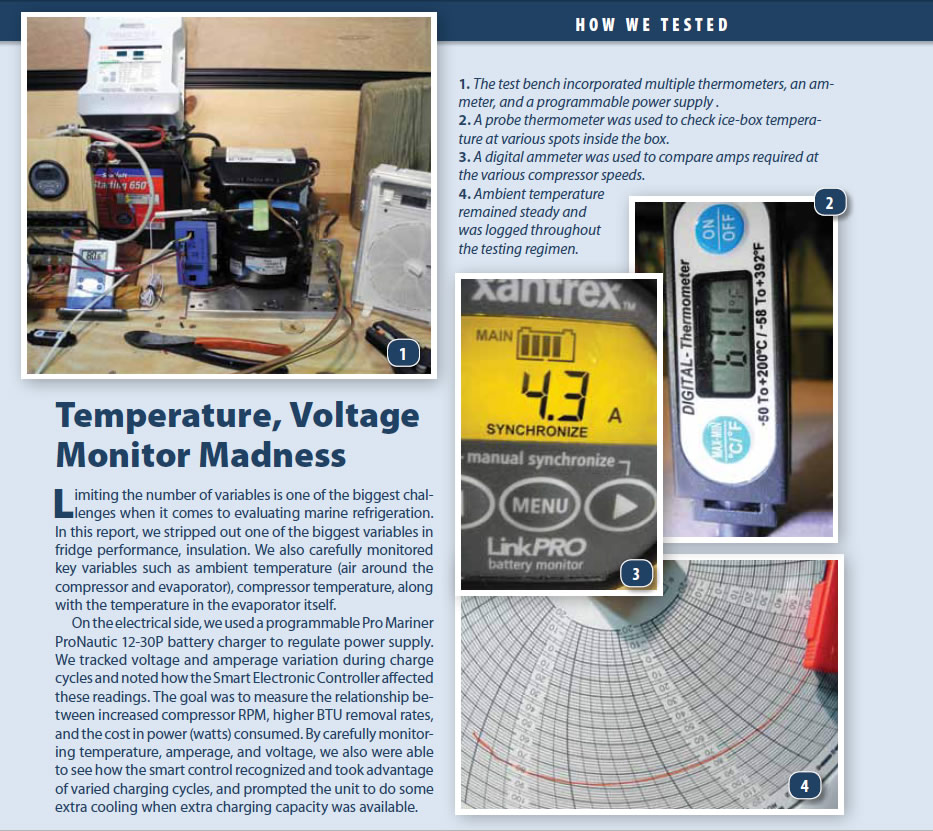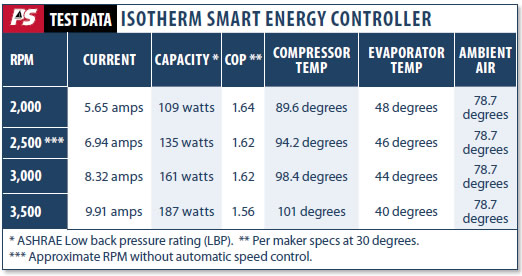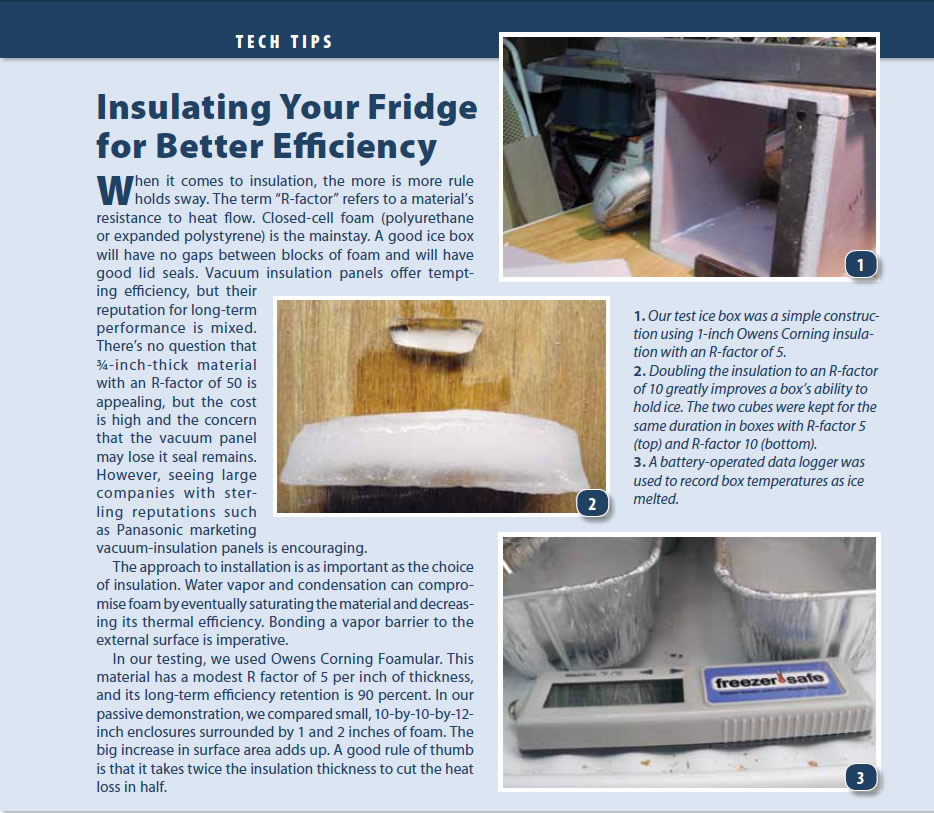
Right alongside turning lead into gold and the quest for perpetual motion, the sailors hunt for low-energy ways to keep things cold resides in the realm of too good to be true. Yes, sailboat refrigeration systems can be made more efficient, and skippers can reshuffle the way in which cooling-or more accurately, heat removal-takes place. But the fact remains that turning water into ice demands energy, and that energy has to come from somewhere.
In this update to our marine refrigeration tests (PS, April and June 2009), we evaluate a new product and review recent trends in marine refrigeration. We also look at why manufacturers have settled on electrically driven, hermetically sealed compressors and larger battery banks and alternators.
Background
Fridges gobble amps. With large battery banks, you can get away with a weekend amp-hour splurge, and hold off on serious charging until youre back in your boat slip. You might even get away with this for weekends in a row without needing to buy a high-output alternator. But when a long-term cruise is in the cards, trying to manage energy input and output becomes an electron juggling act.
A small DC compressor seems modest in current demand, often rated at around 4 or 5 amps when running in a 12-volt DC system. However, the devil is in the details, and in this case, the killer is the duty cycle, or how long the unit actually runs during a 24-hour period. Ambient temperature, run time, box size, and insulation efficiency help dictate the actual number of watts or amp-hours consumed. Theres a big difference in energy demand between those cruising Maine in May with a well-insulated refrigerator and those roaming around Florida in the summer with a poorly insulated box. The energy demand of the latter can easily double that of the former.
In the days of mechanical refrigeration, when belt-driven automotive air-conditioning compressors were bolted to the diesel, box temperature was like a bipolar mood swing.
At the heart of the problem was the hour or two of engine run time required to freeze the eutectic solution in the holding plate(s). Like metal sequels to block ice, the plates kept the fridge cold while the engine was off. Run time revolved around cooling capacity, and because the process wasnt temperature regulated, freezing the lettuce and melting the ice cream was accepted as part of the excitement of boating.
The upside of the mechanical approach was rapid cooling and low electrical demand of these systems. In a way, mechanical refrigeration was quite a miracle-when it worked. Unfortunately, maintenance costs often surpassed the cost of the unit itself. Multiple belts, brackets, hose connections, and junctions kept so-called freon jockeys in high demand.
The trend today is toward more reliable, electrically driven compressors that automatically cycle on and off. Temperature ranges are more tightly controlled; lettuce doesn’t freeze, and the ice cream stays hard. Impromptu freezer parties have become a thing of the past, but the cost of reliable, temperature-stable refrigeration involves a hefty investment in a battery bank (12- or 24-volt DC) and charging system.
As marine refrigeration guru Mike Adler predicted 30 years ago, Danfosss hermetically sealed compressors (BD35F and BD50F) are now the standard for sailboats. This design, which places the electric motor, drive shaft, and compressor in an airtight canister, eliminates an old Achilles heel-unnerving leaks at the driveshaft seal. Replacing the mechanical commutator with an electronic controller was another big evolutionary step.
These rugged little units get high reliability ratings, but their capacity for heat removal-measured in British thermal units (BTU)-is quite modest. (One BTU equals the amount of heat required to raise the temperature of 1 pound of water l degree.)
When compared with bygone, mechanically driven compressors, the modest Danfoss units perform like a trusty 3-horsepower outboard next to a 9.9-horsepower kicker. Both will get you from A to B, but the former will have to run a lot longer.
Intelligent Control
A new trend toward smart controllers make the Danfoss units even more efficient by automatically conforming to the vessels varied charging routine. This involves altering compressor RPM to make better use of surplus energy. Built into these aftermarket compressor control units is a means to vary the RPM rate. When the controller senses higher voltage associated with charging, it speeds up the compressor, allowing more refrigerant to pass through the evaporator or holding plate.
Danfoss introduced its own automatic control module in 2003, but few fridge manufacturers incorporated it into their systems. More recently, entrepreneurial engineers began tweaking the control algorithms and introducing their own controllers.
In the April 2009 issue, we tested the programmable Sensistat from SCAD Marine ($300), and in the June 2009 fridge test, we looked at the Frigoboat Speed Board ($40), a simple controller that lets you manually adjust the RPM on a Danfoss-compressor. Both products proved advantageous for certain types of cruising sailors.
This month, we look at the $150 automatic Smart Energy Controller (SEC) from Isotherm, a division of Indel-Webasto and a major player in the marine and RV markets. Generally, the controllers functions overlap those of the Sensistat, which has a little more programming flexibility and a digital display. Frigoboat has since introduced the Merlin ($135), an automatic controller similar to the Isotherm SEC.
Isotherms engineers recognize that an alternator puts out its maximum charge rate for a very short period. Once the batteries have reached a certain state of charge, the alternator (or any other DC power source) offers a source of untapped energy. By creating smart refrigeration controllers that can sense these periods of electrical abundance, more efficient cooling can take place.
Conversely, when the batteries arent charging, the smart controller can dial back the RPM of the compressor and use less current. The slowest RPM for a Danfoss BD35F or 50F compressor is 2,000 RPM; the highest is 3,500 RPM. The default setting on most off-the-shelf fridge packages varies, but is usually set around 2,500 RPM. The current requirements of running at the maximum 3,500 RPM are significant. We recorded a 50-percent increase in power usage when the charging voltage rose to 14.6 volts and the compressor automatically jumped from the default of about 2,500 RPM to the maximum. One of our aims was to find out just how much cooling benefit we got from those extra RPM.
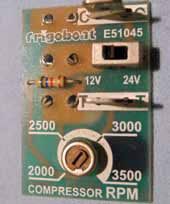
Testing
Back in April 2006, our evaluation of the Danfoss BD35F and 50F hermetically sealed compressors and evaporator systems showed why these systems have a firm hold on the marine refrigeration market. They are very reliable, efficient and nearly silent partners aboard a sailboat. The aluminum evaporators will corrode, but we have had units go well beyond the decade milestone.
That test was our first experience with the Frigoboat Smart Board. Easy to install, the Smart Board plugged right into male spade connectors on the Danfoss controller box. A potentiometer allowed the user to manually change the compressor from 2,000 to 3,500 RPMs.
As the coefficient of performance (COP) curves for the Danfoss BD50 indicate (see table), theres slightly more efficiency gained at the low end of the RPM range. Running the maximum RPM amounted to approximately a 60-percent increase in BTU removal rate (at 30 degrees), but the jump from lowest to highest RPM results in an 80-percent increase in power demand. Dialing up the RPM manually works, so long as you are paying close attention to the state of your battery.
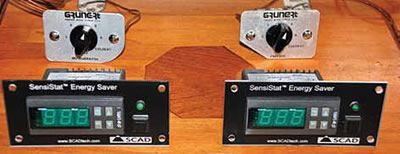
Like the Smart Board, the Isotherm SEC regulates compressor RPM spanning the 2,000 to 3,500 range. But it does it automatically. At the low end, less current is consumed but less coolant is circulated through the evaporator or holding plate. By changing the resistance in the controller, the RPM can be increased, sending more 134A through the system, and boosting capacity.
In order to determine whether or not the Isotherm SECs automated approach made sense, we looked at co-efficient of performance curves for the BD50F compressor and did our own testing to validate input/output energy ratios. In short, we tracked how power (watts) fed to the compressor linked to cooling changes in the evaporator.
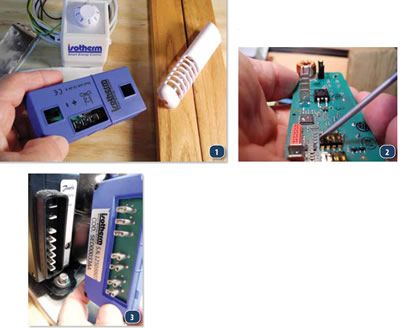
Conclusion
At the end of the day, we found that efficiency is more a matter of timing than compressor RPM. Ideally, every time you need maximum chill to cool down those warm beverages, you have extra amps available. And every time you drop the hook, your fridge is full of frozen peas acting as eutectic solution and slowing down the loss of heat. Fridge temperature, availability of extra charging amps, and efficient thermostatic control can be merged to find a sweet spot.
Isotherm touts at least a 35-percent power savings, up to 50 percent when combined with the cooling effects of stored energy in food and drinks. We found we could increase efficiency by 15 to 25 percent using the Isotherm, and about 35 percent when chilled food or drinks were helping keep the box cold.
As might be assumed, the unit used more power at higher compressor RPM than at low RPM. In the 20- to 45-
degree temperature range, increasing from 2,000 RPM to 3,500-RPM gobbled up roughly 4.5 amps. Looking at the coefficients of performance in this range shows that the energy savings at low RPM and the capacity increase at higher RPM balance out, regardless of RPM. More energy equals more capacity.
As long as extra alternator capacity is available, optimum battery charging and full-power Danfoss operation can coexist. A 20-minute run into or out of the harbor wont be much help. But when motoring through a calm, or enjoying a midday spike in solar-panel or wind-generator output, banking this extra energy as extra coolness in the box will ease the load on the battery bank. These energy-abundant periods are also the time to load up the warm beer or stick some water in trays to make ice cubes.
Insulation is the other side of the efficiency coin, and it involves no moving parts and no electrical consumption to run. We are always surprised by how many new-boat manufacturers tout the cubic footage of the box but fail to mention insulation specs. Some have the refrigerator next to the engine compartment, while others place the refer/freezer up against the black gel-coated hull. Fridge design is worth more serious consideration.
The real villain when it comes to low-energy refrigeration is how much warm stuff to keep putting in the box. It makes sense to avoid loading up the fridge with warm groceries during the time of day with the highest current demand.
Keep in mind that battery bank discharge is not linear, and just because you might be able to draw 5 amps for 24 hours before a fully charged house bank is fully discharged, this doesn’t mean that you can draw 20 amps for six hours. Both scenarios amount to 120 amp hours of current use, but battery capacity is much greater when the rate of energy withdrawal is lower. Therefore, make sure that you stuff in the warm groceries when the other loads on the house bank are at their lowest, or even better, when youre motoring or when alternate energy inputs are peaking.
For the BTU-conscious cruiser who cares about hoarding amps, the $150 spent on the Isotherm SEC can yield returns, but not miracles. Based on our tests, a vigilant cruiser with a well-designed fridge and ample charging capability could do fine with a manual control or none at all, but the key word is vigilant. With so many other systems to track onboard, sometimes its nice to let someone else watch the fridge for us.
